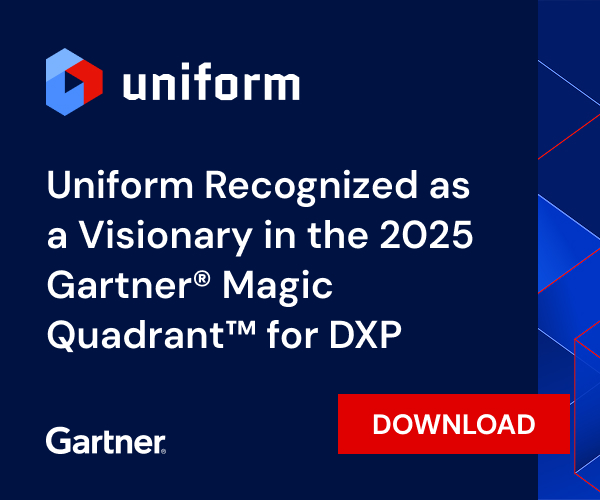How many strategic decisions are you making today that will become tomorrow's biggest regrets? While you are evaluating martech platforms based on current requirements, your competitors are building martech stacks that bend without breaking when markets shift unexpectedly.
True future-proofing means building adaptability into your marketing technology foundation so you can pivot when markets shift, customers change, and new technologies emerge.
Most future-proofing conversations focus on technical requirements. Can the platform integrate with emerging technologies? Does it support headless architecture? Will it scale with our growth?
These questions matter, but they miss the bigger picture. Technology specs become outdated faster than your morning coffee gets cold. What doesn't change is your need to respond quickly to market opportunities.
Here's what this looks like in practice: A healthcare platform is built with cutting-edge
personalization and
AI capabilities; six months later, when telemedicine explodes, the "future-ready" system can't adapt fast enough. Competitors who had focused on flexibility rather than features capture market share while the original company spends months rebuilding.
Real future-proofing means building systems that bend without breaking when the unexpected happens.
Innovative marketing leaders are shifting toward composable architectures. Instead of monolithic platforms that do everything moderately well, they're building ecosystems of specialized tools that work together seamlessly.
Composable architectures deliver adaptability through modularity. New channels require additional components, not system replacements. Shifting customer behavior means workflow reconfiguration, not infrastructure rebuilds. Better tools join your ecosystem without operational disruption.
The
Uniform composable DXP connects your existing martech investments while preserving evolution flexibility. Marketing teams control cross-platform experiences through visual interfaces, eliminating developer dependencies for routine updates. Requirements expand through capability extension, not ground-up reconstruction.
It is easy to fixate on the latest platform features, but what determines success is whether your team can adapt when everything changes overnight.
Take financial services as an example. A firm spends $2.8 million on what their vendor calls a "revolutionary customer experience platform." Six months later, regulatory changes force them to restructure their compliance workflows completely. The platform can not handle it. Worse, their team has become so dependent on the system's automated processes that they are unable to manually configure new approaches. They lose three major clients while scrambling to rebuild basic capabilities.
The alternative approach proves more effective. An organization invests half that budget in cross-training its marketing operations team. When similar regulatory shifts hit their industry, they reconfigure their entire customer journey using tools they already own within two weeks. Their competitors are still arguing with vendors about custom development timelines.
Strategic learning investments that create lasting competitive advantage:
- Cross-functional training programs that develop skills transferable across platforms and technologies
- Experimentation budgets dedicated to testing new approaches without fear of failure
- Regular collaboration sessions between marketing and technical teams to break down silos
- External learning partnerships with vendors, agencies, and industry experts who bring fresh perspectives
The most successful organizations treat learning as infrastructure investment, not optional expense.
Features become commoditized. Market positioning doesn't.
Rather than chasing the latest capabilities, future-focused organizations build positions that remain relevant regardless of technological shifts. They understand their customers deeply enough to anticipate needs before tools exist to meet them.
Look at retail for proof of this approach. Companies can focus on understanding customer journey complexity instead of implementing every new personalization feature. When new touchpoints emerge, they know exactly how to integrate them. Their consistent customer experience becomes their differentiator, not their technology stack.
This mindset shift changes how you evaluate platforms. Instead of asking "What can this do?" you ask "How will this help us adapt to what we don't know yet?"
Avoiding vendor lock-in is the most future-proof decision you can make. No platform will solve tomorrow's problems, regardless of today's promises.
Modern composable platforms like Uniform understand this reality. They're designed to complement other systems rather than replace them entirely. Thus, you can connect existing investments while maintaining the flexibility to add new capabilities.
This approach protects your technology investments. When better solutions emerge, you integrate rather than migrate. When business requirements change, you reconfigure rather than rebuild. When vendors disappoint, you replace components rather than entire ecosystems.
Future-proofing starts with
implementation philosophy, not technology selection. Build for change rather than perfection. Plan for evolution rather than completion. Design for teams rather than processes.
Start small and prove value quickly. Build confidence through success rather than promises. Expand capabilities based on actual needs rather than theoretical requirements. This approach creates momentum while maintaining flexibility.
True future-proofing acknowledges uncertainty while preparing for it. You can not predict which technologies will matter in five years, but you can build systems that adapt when they emerge.
The organizations thriving today didn't predict the pandemic, social commerce explosion, or AI revolution. They built foundations flexible enough to capitalize on unexpected opportunities.
Future-proofing means building the right capabilities to succeed regardless of which technologies emerge. That's the difference between surviving change and leveraging it for competitive advantage.
Ready to experience true marketing adaptability? The
Uniform composable DXP transforms how teams build, manage, and optimize digital experiences without the technical bottlenecks that slow competitors down.
Schedule a personalized demo to see how leading organizations create future-ready marketing operations that respond to opportunities at market speed, not development speed. When it comes to building systems that adapt and scale, seeing is believing.






.png&w=1080&q=90)
.png&w=1080&q=90)
.png&w=1080&q=90)